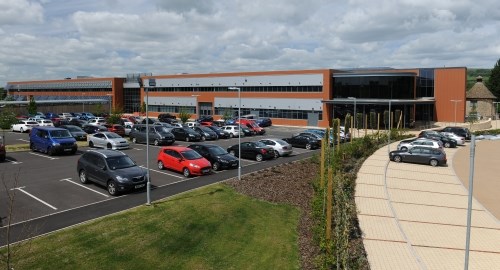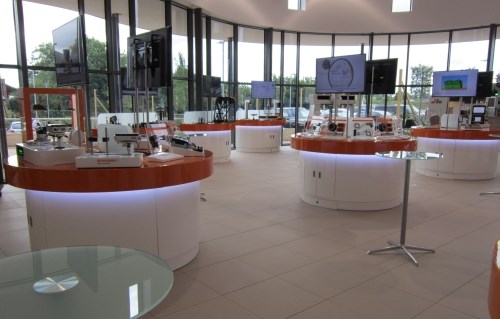Visiting Renishaw in the UK
The unveiling of Renishaw’s new 153,000-square-foot Innovation Center gave me a good opportunity to visit a company in the UK that I’ve known for years.
Share




Renishaw’s new Innovation Center houses R&D and corporate services staff, as well as demonstration, training and conference areas.
I know Renishaw fairly well. I had been following and writing about its myriad metrology technologies even before joining Modern Machine Shop back in 2004, having worked seven years prior to that for a public relations agency that had Renishaw as a client.
Due to scheduling conflicts and various other circumstances, though, I hadn’t had the chance to visit the company’s operations in the UK. Luckily, I got that opportunity last week, being the sole U.S. editor invited to a press event to tour Renishaw’s new Innovation Center located at the company’s headquarters near Wotton-under-Edge, Gloucestershire and get a preview of the products the company is introducing at EMO this October.
The 153,000-square-foot Innovation Center represents a £20 million ($31 million) investment and is the first phase of a development that includes the approval for 77,000 square feet of additional space. The facility houses R&D and corporate services staff, as well as demonstration, training and conference areas, and is the first such demonstration center to house all of the company’s product lines, which includes spectroscopy, healthcare and laser calibration.

The Innovation Center is the first such demonstration center to house all of the company’s product lines, including metrology, spectroscopy additive manufacturing and health care.
The energy-efficient building includes a number of machine tools and CMMs to demonstrate Renishaw’s latest probing, gaging, ballbar, laser calibration and software solutions, including the following that will be on display at EMO (which illustrate how the company is striving to make applying and using its technology easier and more affordable):
- The Intuo gauging software for the company’s Equator inspection system is designed to simplify and automate the gaging of a wide variety of parts, removing dependence on the skill of manual gage users and offering an alternative to multiple devices such as Vernier or digital calipers, micrometers and plug gauges. The software enables a programmer to create gaging routines using just a part with an engineering drawing. With the Feature Predict function activated, the programmer uses the Equator’s joystick to take points on each part feature, and the software predicts the type of feature, the nominal value and a possible tolerance band.
- The Modus 2 metrology software suite brings efficiency to the programming and operation of CMMs. Based on the existing Modus platform, and supporting Renishaw’s range of three- and five-axis CMM sensor technologies, Modus 2 includes an intuitive interface and faster programming. The user experience is designed to be identical whether the software is connected to a “live” CMM or is working offline environment where full simulation with speed control facilitates measurement sequence development and visualization.
- The Primo twin-probe system (which includes the Primo Radio Part Setter, Primo Radio 3D Tool Setter, Primo interface and GoProbe training kit) is said to offer the advantages of automated setting with a “pay-as-you-go” credit token business model that combines minimal up-front costs, a free, comprehensive training package, and immediate parts replacement. The six-month credit token enables unlimited use of the Primo twin-probe system during that period. Once the credit expires, users can simply purchase an additional credit token to extend usage.

Machine tools of various brands and sizes are used to demonstrate Renishaw’s numerous probing and calibration solutions.
I was also invited to see two of Renishaw’s other facilities during this trip. One was the new Additive Manufacturing Products Division location in Stone, Staffordshire. (And as you might have heard, Clive Martell, former president and CEO of Delcam, is now Renishaw’s head of global additive manufacturing.) The company moved its additive division to this 90,000 square foot building back in March. The facility includes individual private “hot cells” the company will set up for manufacturers to privately test additive manufacturing equipment for their own products. This concept will be replicated in facilities in other countries. Another building at this site is home to Renishaw’s vacuum casting division. This technology involves encasing a master model in silicone rubber and applying a vacuum to make a mold. It is a bridge between additive manufacturing equipment and full production molds for quantities of 500 pieces or fewer.
Finally, I was finally able to visit Renishaw’s Stonehouse machine shop, where the company applies its RAMTIC (Renishaw’s Automated Milling, Turning and Inspection Center) concept. This machining approach was developed in the early ‘90s as a solution for effective process control during unattended production of components for the company’s metrology products. Through the use of standardized work fixtures and mobile carousels, master workpiece artifacts, and on-machine probing routines, RAMTIC enables machine tools to maintain control of precision machining processes on their own. Mark Albert, MMS editor-in-chief, wrote this article in 2007 about the approach, and I wrote this follow-up piece about it a couple years later.
Related Content
Turning Fixed-Body Plug Gages Inside Out
Fixed-body mechanical plug gages provide fast, high-performance measurement for tight-tolerance holes.
Read MoreBallbar Testing Benefits Low-Volume Manufacturing
Thanks to ballbar testing with a Renishaw QC20-W, the Autodesk Technology Centers now have more confidence in their machine tools.
Read MoreMachined Part Geometry Measurement
Uncertain about uncertainty? Having trouble remembering the difference between accuracy and precision? Read on to review key metrology terms relevant to the ISO Guide to the Expression of Uncertainty in Measurement (ISO GUM).
Read MoreMarathon Precision’s Engineering Playground: One Shop’s Secret to Sustaining High Tech, Low-Volume and High Morale
Half an airplane on the wall, a ten-foot metal dragon, and a full-blown recording studio might not scream “manufacturing efficiency,” yet Marathon Precision proves otherwise. Here’s how forging, complex CNC operations and staff-driven creative projects combine to fuel the shop’s productivity and profitability.
Read More

























